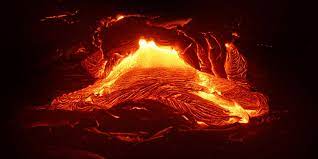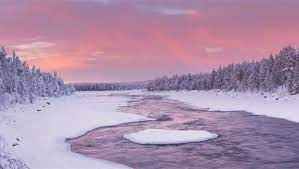Magma
"Magma Magic: The Science of Molten Rock"
Magma is a term used in geology to describe molten rock material that exists beneath the Earth's surface. It's essentially a mixture of various components, including molten rock, suspended mineral crystals, dissolved gases, and sometimes even solid rock fragments. Magma is the precursor to volcanic activity, and its properties and behavior play a crucial role in shaping the Earth's surface and contributing to geological processes.
Here's a more detailed description of magma:
Composition: Magma is primarily composed of silicate minerals, which are compounds of silicon and oxygen. These minerals are the building blocks of most rocks on Earth's crust. Other elements and compounds can also be present in magma, including gases like water vapor, carbon dioxide, sulfur dioxide, and various other volatile elements.

Formation: Magma forms due to the intense heat and pressure deep within the Earth's interior. As rocks are subjected to high temperatures in the mantle, they can start melting, forming molten rock material. This molten material is less dense than the surrounding solid rock, which allows it to rise toward the Earth's surface.
Magma Chambers: Magma accumulates in underground chambers within the Earth's crust, often in areas near tectonic plate boundaries. These magma chambers can be relatively small or extensive, and they serve as reservoirs that feed volcanic eruptions.
Volcanic Eruptions: When the pressure and gases within a magma chamber become too great, the magma can forcefully erupt to the surface. This eruption can result in various volcanic phenomena, such as lava flows, ash clouds, pyroclastic flows, and more.
Lava: Once magma reaches the Earth's surface, it's referred to as lava. Lava can vary in composition, viscosity (thickness), and temperature. These variations lead to different types of volcanic activity and landforms.
Influence on Landforms: The solidified products of magma and lava are responsible for the creation of various geological features, including volcanoes, volcanic islands, lava plateaus, and volcanic calderas.
Scientific Study: Understanding magma's composition, behavior, and movement is essential for predicting and mitigating volcanic hazards. Scientists study magma to better comprehend the processes occurring beneath the Earth's surface and develop early warning systems for potential eruptions.
In summary, magma is the molten rock material that resides beneath the Earth's surface and plays a fundamental role in volcanic processes and landform creation. It's a dynamic and complex substance that has captivated the interest of geologists and scientists for decades due to its role in shaping the Earth's geological history.
Magma is a term used in geology to describe molten rock material that exists beneath the Earth's surface. It's essentially a mixture of various components, including molten rock, suspended mineral crystals, dissolved gases, and sometimes even solid rock fragments. Magma is the precursor to volcanic activity, and its properties and behavior play a crucial role in shaping the Earth's surface and contributing to geological processes.
Here's a more detailed description of magma:
Composition: Magma is primarily composed of silicate minerals, which are compounds of silicon and oxygen. These minerals are the building blocks of most rocks on Earth's crust. Other elements and compounds can also be present in magma, including gases like water vapor, carbon dioxide, sulfur dioxide, and various other volatile elements.

Formation: Magma forms due to the intense heat and pressure deep within the Earth's interior. As rocks are subjected to high temperatures in the mantle, they can start melting, forming molten rock material. This molten material is less dense than the surrounding solid rock, which allows it to rise toward the Earth's surface.
Magma Chambers: Magma accumulates in underground chambers within the Earth's crust, often in areas near tectonic plate boundaries. These magma chambers can be relatively small or extensive, and they serve as reservoirs that feed volcanic eruptions.
Volcanic Eruptions: When the pressure and gases within a magma chamber become too great, the magma can forcefully erupt to the surface. This eruption can result in various volcanic phenomena, such as lava flows, ash clouds, pyroclastic flows, and more.
Lava: Once magma reaches the Earth's surface, it's referred to as lava. Lava can vary in composition, viscosity (thickness), and temperature. These variations lead to different types of volcanic activity and landforms.
Influence on Landforms: The solidified products of magma and lava are responsible for the creation of various geological features, including volcanoes, volcanic islands, lava plateaus, and volcanic calderas.
Scientific Study: Understanding magma's composition, behavior, and movement is essential for predicting and mitigating volcanic hazards. Scientists study magma to better comprehend the processes occurring beneath the Earth's surface and develop early warning systems for potential eruptions.
In summary, magma is the molten rock material that resides beneath the Earth's surface and plays a fundamental role in volcanic processes and landform creation. It's a dynamic and complex substance that has captivated the interest of geologists and scientists for decades due to its role in shaping the Earth's geological history.
#Magma
#Volcano
#Geology
#Lava
#VolcanicActivity
#Eruption
#HotMagma
#MagmaChamber
#VolcanicEruption
#MagmaFlow
#PyroclasticFlow
#VolcanicAsh
#MagmaScience
#VolcanicResearch
#Volcanology
#Volcano
#Geology
#Lava
#VolcanicActivity
#Eruption
#HotMagma
#MagmaChamber
#VolcanicEruption
#MagmaFlow
#PyroclasticFlow
#VolcanicAsh
#MagmaScience
#VolcanicResearch
#Volcanology
Facebook: https://www.facebook.com/profile.phpid=100087106114908
Twitter : https://twitter.com/bestpaperaward
Pinterest : https://in.pinterest.com/bestpaperaward
Linkedin : https://www.linkedin.com/in/esha-gupta-18b2b4245
Instagram: https://www.instagram.com/eshagupta__2022/
Twitter : https://twitter.com/bestpaperaward
Pinterest : https://in.pinterest.com/bestpaperaward
Linkedin : https://www.linkedin.com/in/esha-gupta-18b2b4245
Instagram: https://www.instagram.com/eshagupta__2022/



Comments
Post a Comment